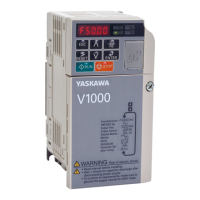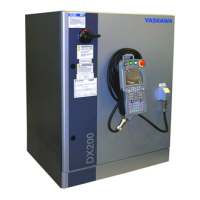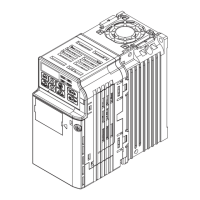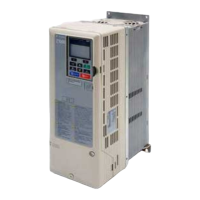6.9 Troubleshooting without Fault Display
274 YASKAWA ELECTRIC SIEP C710606 44B YASKAWA AC Drive T1000V Technical Manual
■ Overvoltage Occurs When Running at a Constant Speed
■ Motor Stalls During Acceleration or With Large Loads
■ Motor Will Not Accelerate or the Acceleration Time is Too Long
Cause Possible Solutions
Excessive load inertia in Open Loop Vector Control.
• Loads with a lot of inertia (fans, etc.) can trigger an overvoltage fault when operating in
Open Loop Vector Control.
• Switch to the V/f motor control method.
• Adjust the values set for the speed feedback detection control time constant (n2-02 and
n2-03).
Cause Possible Solutions
Load is too heavy.
Take the following steps to resolve the problem:
• Reduce the load.
• Increase the acceleration time.
• Increase motor capacity.
• Although the drive has a Stall Prevention function and a Torque Compensation Limit
function, accelerating too quickly or trying to drive an excessively large load can exceed
the capabilities of the motor.
Cause Possible Solutions
Frequency reference is too low.
• Check the maximum output frequency (E1-04).
• Increase E1-04 if it is set too low.
Check U1-01 for proper frequency reference.
Check if a frequency reference signal switch has been set to one of the multi-function input terminals.
Check for low gain level set to terminals A1 or A2 (H3-03 or H3-11).
Load is too heavy.
Reduce the load so that the output current remains within the motor-rated current.
Check if the mechanical brake is fully releasing as it should.
The torque limit function is
operating in Open Loop Vector
Control.
• Check the torque limit setting. It may be too low. (L7-01 through L7-04).
• Reset the torque limit to its default value (200%).
Acceleration time has been set too
long.
Check if the acceleration time parameters have been set too long (C1-01, C1-03, C1-05, C1-07).
Motor characteristics and drive
parameter settings are incompatible
with one another in V/f Control.
• Set the correct V/f pattern so that it matches the characteristics of the motor being used.
• Check V/f Pattern.
The right combination of motor
characteristics have not been set in
Open Loop Vector Control.
Execute Rotational Auto-Tuning.
Incorrect frequency reference
setting.
• Check the multi-function analog input settings.
• Check if multi-function analog input terminal A1 or A2 is set for frequency gain (H3-02 or H3-10 = “1”). If
so, the frequency reference will be 0 if there is no voltage (current) input provided.
• Ensure H3-02 and H3-10 are set to the proper values.
• Ensure the analog input value is set to the right value (U1-13 or U1-14).
The Stall Prevention level during
acceleration and deceleration set
too low.
• Check the Stall Prevention level during acceleration (L3-02).
• If L3-02 is set too low, acceleration will take a fair amount of time.
• Increase L3-02.
The Stall Prevention level during
run has been set too low.
• Check the Stall Prevention level during run (L3-06).
• If L3-06 is set too low, speed will drop as the drive outputs torque.
• Increase the setting value.
Although the drive is operating in
Open Loop Vector motor control
method, Auto-Tuning has not been
performed.
• Perform Auto-Tuning.
• Calculate motor data and reset motor parameters.
• Switch to the V/f motor control method (A1-02 = “0”).
Drive reached the limitations of the
V/f motor control method.
• The motor cable may be long enough (over 50 m) to require Auto-Tuning for line-to-line resistance.
• Be aware that V/f Control is comparatively limited when it comes to producing torque at low speeds.
• Consider switching to Open Loop Vector Control.
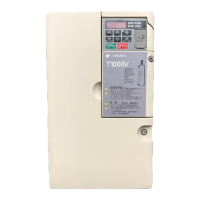
